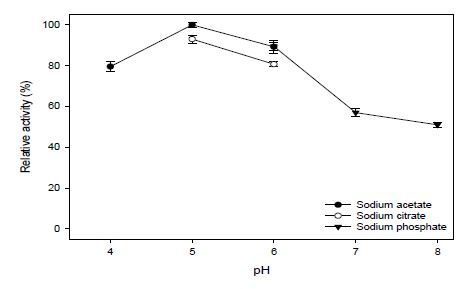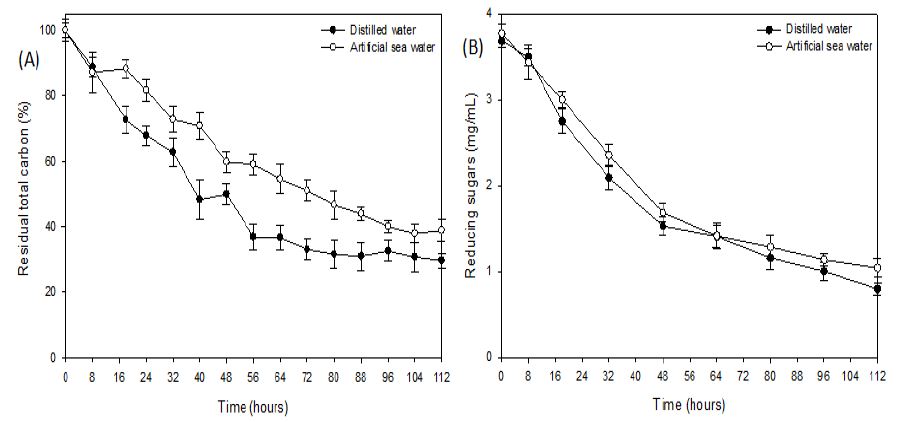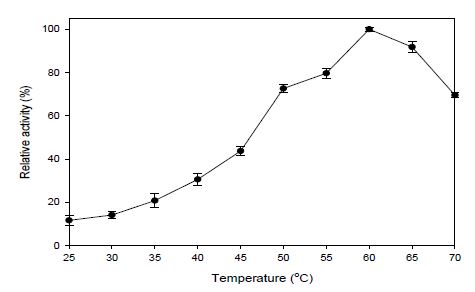
비타민나무 열매에서 분리한 Aureobasidium pullulans의 동정 및 Amylase 활성
Abstract
A new yeast strain isolated from Sea Buckthorn (Hippophae rhamnoides L.) fruits was identified and the characteristics of its amylase activity were investigated. A wild yeast strain isolated from Sea Buckthorn (Hippophae rhamnoides L.) fruits was identified as Aureobasidium pullulans using the morphological observations and ITS1-5.8S rRNA-ITS2 PCR. This A. pullulans strain showed the highest amylase activity under the condition of a sodium acetate buffer (pH 5.0) and 60℃. On the other hand, the optimal reaction temperature of the amylase activity of A. pullulans previously isolated from the ocean was 28℃. These results indicate that the enzyme activities of A. pullulans isolated from different sources might not be the same. Unlike previous studies on A. pullulans from the ocean, starch was metabolized more rapidly and the specific activity of amylase was three times higher in the cultures using the distilled water base media compared to the artificial sea water base media. These results suggest that newly isolated A. pullulans from Sea Buckthorn (Hippophae rhamnoides L.) fruits may possess unique enzymatic profiles, which is different from previously isolated A. pullulans.
Keywords:
sea buckthorn, Aureobasidium pullulans, amylase activity서론
Aureobasidium pullulans은 생성된 멜라닌으로부터 기인하는 검은 색으로 인해 black yeast로 알려진 yeast-like fungus의 일종으로 초기에는 노란색, 백색 혹은 핑크빛을 띄다가 시간이 지나면 검은 색으로 변하는 것이 특징이다(de Hoog GS 1993). 또한 형태적 유연성이 커 탄소원이나 온도, 시간에 따라 균락의 모양 등이 달라지는 특징을 지니고 있다(Slepecky RA & Starmer WT 2009).
A. pullulans에 장기간 노출될 경우, 과민성 폐렴을 유발해 인체에 유해할 수 있다고 여겨져 왔으나(Temprano J 등 2007), 유전적 서열 분석결과 과민성 폐렴을 유발하는 균주는 A. melanogenum으로 재분류되어 최종적으로 다른 균주임이 밝혀졌으며, 이외에도 아종으로 Aureobasidium melanogenum, Aureobasidium subglaciale, 그리고 Aureobasidium namibiae가 새로이 재분류되었다(Gostinčar C 등 2014).
A. pullulans가 생산하는 주된 유용물질로는 pullulan이 보고되고 있으나(Duan XH 등 2008) pullulan 이외에도 alkaline protease(Chi Z 등 2009), β-glucosidases(Leite RSR 등 2007), lipase(Liu ZQ 등 2008), cellulase(Zhang L & Chi ZM 2007), xylanase(de Wet BJM & Zyl Prior WHBA 2006), mannanase (Kremnický L & Biely P 1997), amylase(Li HF 등 2007a) 등의 효소 생성 역시 보고되어 있다. 와인양조 분야에서는 고전적으로 A. pullulans가 오크배럴 내에서 숙성 중인 와인을 오염시키는 오염원으로 여겨지고 있지만(Fugelsang K & Edwards C 2010), A. pullulans가 생산하는 β-glucosidases를 이용해 와인 내에서 당과 결합해 수용성 상태에 있는 향미 성분들의 β-글루코시드 결합을 끊어 와인의 향미증진을 도모한 연구도 수행된 바 있다(Baffi MA 등 2013).
위의 효소들 중 amylase는 전분을 글루코스로 구성된 더 작은 단위의 분자로 가수분해하는 효소(Windish WW & Mhatre NS 1965)로 에탄올 생산, 제지, 섬유, 제빵, 맥주 양조 등에 폭넓게 이용되어(de Souza PM & de Oliveria P 2010) 상업적으로 그 중요도가 높은 효소이다. 현재 해양에서 채취한 A. pullulans 유래 amylase의 특성에 대한 연구는 진행되었으나(Li HF 등 2007b), 국내에서 비해양 유래 A. pullulans 연구는 진행된 바가 없다. A. pullulans가 해양환경뿐만 아니라, 과실, 토양, 빙하 속과 같은 극한 환경에서도 발견되는 균주인 만큼 해양 유래가 아닌 균주의 특성에 대해서도 연구할 필요성이 있다.
본 연구에서 A. pullulans 분리 소재로 사용한 비타민나무(Hippophae rhamnoides L.)는 면역, 항염 및 노화방지에 뛰어난 것으로 알려져 새로운 식품소재의 활용 가능성에 대한 관심이 증대되고 있으나(Tiffany TYG 등 2005), 암세포 MCF-7에 대한 생육저해 활성(Olsson ME 등 2004), 항산화 및 미백 활성(Ko MS 등 2012), 타이로시네이즈 저해활성(Kim EJ 등 2011) 등 생리활성에 대하여 부분적인 연구가 진행되었을 뿐 산업적 활용 가능성이 큰 효모 균주에 대하여는 선행 연구된 결과가 거의 없는 실정이다. 따라서 본 연구에서는 비타민나무 열매에 분포하는 효모 균주를 분리·동정함으로써 산업적 활용 가능성을 검토하고자 A. pullulans를 분리·동정하고, A. pullulans가 생산하는 amylase의 특성에 대하여 연구하였다.
재료 및 방법
1. 균주 분리
비타민나무 열매(강원도 화천, 2017년 7월 수확) 10 g을 증류수로 세척한 뒤 으깨어 나온 즙을 1 mL 취하고 0.8% NaCl 용액을 사용하여 105배 연속 희석하였다. 그 뒤 희석된 용액을 PD agar(potato extract 0.4%, dextrose 2% 및 agar 1.5%) 배지에 1 mL 도말하여 25℃에서 2일 배양하였다. 얻어진 단일 균락은 PD 배지(potato extract 0.4%, dextrose 2%), 25℃에서 2일, 2회 계대 배양하여 분리하였다. PD agar 및 PD 배지는 Difco(Franklin Lake, NJ, USA) 제품을 사용하였다.
2. DNA 추출
분리된 균주를 10 mL의 PD 배지에서 2일 배양한 뒤 Whatman filter paper No.1(Whatman, Kent, UK)을 통과시켜 균사를 분리하였다. 분리된 균사는 막자사발에 액체 질소를 첨가해 분쇄하였다. 분쇄액 200 μL에 lysis buffer(200 mM Tris-HCl pH 8.5, 25 mM EDTA 및 0.5% SDS) 500 μL와 500 μL의 phenol/chloroform/isoamyl alcohol(25:24:1)을 첨가하여 13,000 rpm에서 30분 원심분리하여 상층액을 얻었다. 상층액 600 μL에 3 M의 sodium acetate 60 μL와 isopropyl alcohol 360 μL를 첨가하여 13,000 rpm에서 5분 원심분리하였다. 상층액을 제거한 뒤 침전된 DNA는 500 μL의 70% ethanol을 첨가해 세척한 뒤 13,000 rpm에서 1분 원심분리하여 상층액을 제거하고 50℃에서 15분 방치하여 잔존하는 ethanol을 제거하였다. 이후 30 μL의 TE-RNase(100 mM Tris-HCl pH 8.0, 10 mM EDTA, 20 μL RNase)를 첨가한 뒤, 37℃에서 15분 이상 반응시켜 RNA를 제거하였다. 얻어진 genomic DNA는 —20℃에서 냉동 보관하였으며, 실험에 사용한 RNase는 Qiagen(Valencia, CA, USA) 제품, 그리고 phenol, chloroform, isoamyl alcohol, isopropyl alcohol 및 ethanol은 Fisher (Hampton, NH, USA) 제품을 사용하였다.
3. 균주 동정
균주의 동정은 ITS1-5.8S rRNA-ITS2 영역을 universal primer인 ITS1(5'-TCC GTA GGT GAA CCT GCG G-3')과 ITS4(5'-TCC TCC GCT TAT TGA TAT GC-3')를 이용해 증폭하여 수행하였다. Thermal cycler(ASTEC PC-320, ASTEC Inc, Fukuoka, Japan)를 이용해 95℃에서 5분 pre-denaturation을 수행한 뒤, 95℃에서 40초, 55℃에서 40초, 그리고 72℃에서 50초씩 30회 반복하고, 72℃에서 5분 동안 post-extension을 수행하였다. 증폭 산물은 0.8% agarose gel 상에서 전기영동하여 정제 후 Macrogen Co.(Seoul, Korea)에 의뢰하여 sequencing을 수행하였다. 분석된 염기 서열은 basic local alignment search tool을 이용해 동정하였다.
4. A. pullulans 배양 및 Amylase의 활성
Soluble starch 1%가 첨가된 YP(yeast extract 2%, peptone 2%) 배지(Difco, Franklin Lake, NJ, USA)에 5 mL의 seed culture를 배양하였다. 26℃, 180 rpm에서 2일 배양된 seed culture는 pH 5.0의 YP에 soluble starch 1%가 첨가된 배지에 접종하고, 26℃, 180 rpm에서 5일 배양하였다. 배양액을 13,000 rpm에서 25분 원심분리하여 상층액을 회수하였고, 100 mM sodium acetate buffer(pH 5.0) 250 μL와 2% soluble starch 250 μL에 500 μL 상층액을 첨가하여 60℃에서 30분 반응시키고, 5분 끓인 다음 환원당을 측정하였다. 1 unit의 amylase 활성은 반응 조건에서 glucose를 standard로 사용하여 분당 1 μmol의 환원당을 생성하는 효소의 양으로 정의하였으며, specific activity는 unit을 상층액에 포함된 총 단백질량으로 나눈 값으로 정의하였다. 총 단백질량은 bicinchoninic acid(BCA) protein assay kit(Thermo Fisher Scientific, Waltham, MA, USA)를 이용해 측정하였으며, bovine serum albumin을 standard로 사용하였다. 또한 A. pulluans amylase의 pH 및 온도에 따른 활성을 보기 위해 pH에 의한 활성 영향은 100 mM의 sodium acetate(pH 4.0∼6.0), sodium citrate(pH 5.0∼6.0) 및 sodium phosphate(pH 6.0∼8.0)의 완충액을 사용하여 측정하였으며, 최적 온도는 100 mM의 sodium acetate(pH 5.0) 완충액을 사용하여 25℃부터 70℃까지 5℃ 간격으로 활성을 측정하였다.
5. 인공 해수와 증류수 배지에서의 A. pullulans의 생장 측정
YP(yeast extract 2%, peptone 2%)에 soluble starch 1%가 첨가된 배지에 5 mL의 seed culture를 배양하였다. 26℃, 180 rpm에서 2일 배양된 seed culture는 사용되는 용매를 증류수와 인공 해수로 달리하여 만든 YP에 soluble starch 1%가 첨가된 배지에 접종하고, pH 5.0으로 맞추어 26℃, 180 rpm에서 5일 배양하였다. 인공 해수는 1 L 기준 NaCl 28.13 g, KCl 0.77 g, CaCl2·2H2O 1.6 g, MgCl2·6H2O 4.80 g, NaHCO3 0.11 g, MgSO4·7H2O 3.5 g을 첨가하여 제조하였다. 5일 동안의 배양 중 8시간 간격으로 2 mL의 배지를 취해 12,000 rpm에서 5분 원심분리하여 얻은 상층액을 시료로 사용하였다.
6. 총 당 및 환원당 측정
시료 중 총 당은 phenol-sulfuric acid 방법을 이용해 측정하였다(DuBois M 등 1956; Masuko T 등 2005). 5% phenol 용액 500 μL와 샘플 500 μL이 포함된 반응액에 3 mL의 99% sulfuric acid를 첨가해 섞은 다음 30℃에서 20분간 방치하여 시료를 제조하였고, 환원당은 dinitrosalicylic acid(DNS) 방법(Miller GL 1959)을 적용하여 100 μL의 반응액을 300 μL의 DNS 용액과 섞어 준 다음 5분 동안 끓여 시료를 제조하였으며, microplate reader(iMark, BioRad, Hercules, CA, USA)를 이용하여 555 nm에서의 흡광도를 측정하여 총 당량 및 환원당을 분석하였다.
결과 및 고찰
1. 균주의 동정
PD agar 배지에 도말된 균주의 형태 및 현미경으로 관찰한 균주의 형태는 Fig. 1과 같았다. 해당 균주는 도말 후 집락 형성 초기에는 옅은 분홍색을 나타내었지만 4℃에서 3주 경과 후에는 완전히 검은색으로 변하는 것을 확인할 수 있었는데, A. pullulans은 생성된 멜라닌으로부터 기인하는 검은색으로 인해 생육 초기에는 노란색, 백색 혹은 핑크색을 띄다가 시간이 지나면 검은 색으로 변한다는 de Hoog GS(1993)의 연구에서와 같은 결과이며, 현미경 관찰에서도 검게 변한 세포와 균사를 확인할 수 있었다. 또한 ITS1-5.8S rRNA- ITS2 영역을 동정한 BLAST의 결과(Table 1)에서도 A. pullulans strains의 서열과 일치하는 것으로 나타나, 비타민나무 열매에서 분리된 효모는 A. pullulans임을 확인할 수 있었다.

Colony shape and molrphologies of Aureobasidium pullulans.Cultured cell(A) and microscopic image(B).
2. 완충액 pH 및 온도에 의한 A. pullulans Amylase의 영향
Sodium acetate(pH 4.0∼6.0), sodium citrate(pH 5.0∼6.0) 및 sodium phosphate (pH 6.0∼8.0) 완충액에서 amylase 활성에 대한 영향을 측정한 결과(Fig. 2), sodium acetate(pH 5.0) 완충액에서 가장 높은 활성을 나타내었으며, pH 7.0 및 8.0의 sodium phosphate 완충액에서는 활성이 거의 나타나지 않았다.

Effects of pH on Aureobasidium pullulans amylase.The reactions were performed using 1% soluble starch as the substrate in 100 mM sodium acetate (pH 4.0∼6.0), sodium citrate(pH 5.0∼6.0), sodium phosphate (pH 6.0∼8.0).
또한 25℃부터 70℃까지 5℃ 간격으로 amylase의 활성을 측정한 결과(Fig. 3)를 보면 낮은 온도 구간에서의 활성은 현저하게 낮았지만 서서히 증가하였고, 50℃부터는 확연히 증가함을 알 수 있었으며, 60℃에서 최적의 활성을 나타내었고, 60℃ 이상의 온도에서는 amylase의 활성이 감소하는 경향을 보였다. 이는 해양 유래 A. pullulans는 28℃에서 최대 활성을 나타낸다고 하였고(Li HF 등 2007a), 40∼50℃에서 최적 활성을 나타내는 Aspergillus 속에 대한 연구결과(Alva S 등 2007; Patel AK 등 2005)와도 상이한 것으로서 비타민나무 열매에서 분리한 효모의 특성으로 인해 다른 결과를 나타낸 것으로 사료된다. 특별하게 내열성을 나타내는 효소의 경우, 산업적인 장점이 있다는 보고(Haki GD & Rakshit SK 2003)가 있는 바 본 효소의 기초적인 연구를 통하여 상업적으로 유용한 효소의 생산이 가능할 것으로 판단된다.
3. 인공 해수와 증류수 배지에서의 A. pulluans 생장 중 총당 및 환원당 함량
증류수와 NaCl이 약 2%가 함유된 인공 해수 배지에서 A. pullulans가 생장하는 동안 잔존하는 soluble starch의 양을 측정한 결과를 Fig. 4에 나타내었다. 인공 해수에 비해 증류수로 배양한 시험군에서 7〜23% 이상 soluble starch가 더 소모되는 것을 알 수 있었으며, 또한 배양 중 soluble starch가 분해되면서 생성되는 환원당들은 증류수에서 배양 시 평균적으로 10% 정도 배지에 낮게 잔존하였다.
이는 인공 해수에 비해 증류수에서 배양 시 탄수화물 에너지원을 더 이용하였다는 것을 의미하며, 또한 배지 내의 환원당 잔존량이 적음은 soluble starch에서 분해된 환원당이 세포의 생장에 사용되었다는 것을 의미한다. 이러한 결과는 기존에 보고된 해양 유래 A. pullulans가 인공 해수의 환경에서 최적 활성을 보였던 것(Li HF 등 2007b)과는 다른 결과이다. 또한 본 연구에서의 두 배양액 중 총 단백질량은 약 5.5 mg/mL로 동일했지만, 해수 배양 유래 amylase의 specific activity는 0.038 unit/mg 정도인 반면, 증류수 배양 유래 amylase는 0.11 unit/mg으로 약 3배 정도 높은 결과를 나타내었는데 이러한 결과는 비타민나무 열매에서 분리된 A. pullulans가 해양 유래 A. pullulans와는 다른 특성을 나타내며, 배양 생산물의 특성에서도 차이를 보일 가능성이 있음을 시사하였다.

Changes of residual total carbon (A) and reducing sugar (B) in Aureobasidium pullulans culture broth according to media base.
한편, A. pullulans 유래 amylase에 대한 보고가 있기는 하나, 세부적인 단백질의 구조 또는 관련 유전자의 연구에 대한 보고는 찾아보기가 어렵다. 최근 A. pullulans를 이용한 pullulan의 생산에서 관찰되는 amylase와 이와 관련될 가능성이 높은 유전자에 대한 보고(Manitchotpisit P1 등 2011)가 있으나, 그 이후의 연구는 부족한 것으로 판단이 된다. 따라서 본 연구에서 선발된 A. pullulans를 활용한 amylase의 관련 단백질 및 유전자에 대한 추후 연구가 꼭 필요할 것으로 판단이 된다.
요약 및 결론
비타민나무 열매에서 분리한 효모는 집락 및 세포의 형태학적 관찰과 ITS1-5.8S rRNA-ITS2 PCR을 사용하여 동정한 결과, A. pullulans로 확인되었다. A. pullulans의 amylase 활성은 sodium acetate 완충액(pH 5.0)에서 반응 시 가장 높은 활성을 나타내었고, 저온에서의 활성은 낮았지만 50℃부터 활성이 증가하여 60℃에서 가장 높은 활성을 나타내었다. 이와 같은 결과는 해양 유래 A. pullulans의 amylase 활성 최적 온도가 28℃였던 것과 비교하면 다른 환경에서 유래된 같은 종의 A. pullulans 유래 효소의 활성이 다를 수 있음을 의미하는 것이다. 또한 해양 유래의 A. pullulans와 다르게 인공 해수보다는 증류수로 배양 시 탄수화물 에너지원을 더욱 빠르게 대사하였고, 생성된 amylase의 specific activity도 증류수로 배양 시 인공 해수 배양과 대비하여 3배 정도 높게 나타났다.
이상과 같이 비타민나무 열매에서 효모를 분리·동정하고 열매 유래 A. pullulans가 생산하는 amylase 활성의 특성을 규명함으로써 시료 유래에 따라 차이가 있음을 확인할 수 있었다. 이와 같은 결과는 여타 생산물에 대하여도 특성의 차이를 보일 가능성이 있음을 시사하고 있으며, 향후 지속적인 연구를 통해 A. pullulans가 생산하는 것으로 알려진 alkaline protease, β-glucosidases, lipase, cellulase, xylanase, mannanase와 같은 효소들에 대해서도 활성의 차이가 있는지를 규명할 필요가 있을 것으로 사료된다.
References
- Alva, S, Anupama, J, Savla, YY, Chiu, P, VyshalI, MS, (2007), Production and characterization of fungal amylase enzyme isolated from Aspergillus sp. JGI 12 in solid state culture, African J Biotechnology, 6(5), p576-581.
-
Baffi, MA, Tobal, T, Lago, JHG, Boscolo, M, Gomes, E, Da-Silva, R, (2013), Wine aroma improvement using a β-glucosidase preparation from Aureobasidium pullulans, Applied Biochemistry & Biotechnology, 169(2), p493-501.
[https://doi.org/10.1007/s12010-012-9991-2]

-
Chi, Z, Wang, F, Yue, L, Liu, G, Zhang, T, (2009), Bioproducts from Aureobasidium pullulans, a biotechnologically important yeast, Applied Microbiology & Biotechnology, 82(5), p793-804.
[https://doi.org/10.1007/s00253-009-1882-2]

-
de Hoog, GS, (1993), Evolution of black yeasts: Possible adaption to the human host, Antonie van Leeuwenhoek, 63(1), p105-109.
[https://doi.org/10.1007/BF00872386]

-
de Souza, PM, de Oliveira, P, (2010), Application of microbial α-amylase in industry-A review, Braz J Microbiol, 41(4), p850-861.
[https://doi.org/10.1590/S1517-83822010000400004]

-
de Wet, BJM, van Zyl Prior, WHBA, (2006), Characterization of the Aureobasidium pullulans α-glucuronidase expressed in Saccharomyces cerevisiae, Enzyme Microb Technol, 38(5), p649-656.
[https://doi.org/10.1016/j.enzmictec.2005.07.018]

-
Duan, XH, Chi, ZM, Wang, L, Wang, XH, (2008), Influence of different sugars on pullulan production and activities of α-phosphoglucosemutase, UDPG-pyrophosphorylase and glucosyltransferase involved in pullulan synthesis in Aureobasidium pullulans Y68, Carbohydr Polym, 73(2), p587-659.
[https://doi.org/10.1016/j.carbpol.2007.12.028]

-
DuBois, M, Gilles, KA, Hamilton, JK, Rebers, PT, Smith, F, (1956), Colorimetric method for determination of sugars and related substances, Anal Chem, 28(1), p350-356.
[https://doi.org/10.1021/ac60111a017]

- Fugelsang, K, Edwards, C, (2010), Wine Microbiology, 2nd Edition, Springer Science and Business Media, NY, p3-28.
-
Gostinčar, C, Ohm, RA, Kogej, T, Sonjak, S, Turk, M, Zajc, J, Zalar, P, Grube, M, Sun, H, Han, J, Sharma, A, Chiniquy, J, Ngan, CY, Lipzen, A, Barry, K, Grigoriev, IV, Gunde-Cimerman, N, (2014), Genome sequencing of four Aureobasidium pullulans varieties: Biotechnological potential, stress tolerance, and description of new species, BMC Genomics, 15, p549.
[https://doi.org/10.1186/1471-2164-15-549]

-
Haki, GD, Rakshit, SK, (2003), Developments in industrially important thermostable enzymes: A review, Bioresour Technol, 89(1), p17-34.
[https://doi.org/10.1016/S0960-8524(03)00033-6]

- Kim, EJ, Chae, KY, Park, SN, (2011), Antioxidative and inhibitory activities on tyrosinase of Hippophae rhamnoides leaf extracts, J Soc Cosmetic Sci Korea, 37(3), p265-273.
- Ko, MS, Lee, HJ, Kang, MJ, (2012), Antioxidant activities and whitening effects of extracts from Hippophae rhamnoides L, J East Asian Soc Dietary Life, 22(6), p812-817.
-
Kremnický, L, Biely, P, (1997), β-Mannanolytic system of Aureobasidium pullulans, Arch Microbiol, 167(6), p350-355.
[https://doi.org/10.1007/s002030050454]

-
Leite, RSR, Gomes, E, Da-Silva, R, (2007), Characterization and comparison of thermostability of purified β-glucosidases from a mesophilic Aureobasidium pullulans and a thermophilic Thermoascus aurantiacus, Proc Biochem, 42(7), p1101-1106.
[https://doi.org/10.1016/j.procbio.2007.05.003]

-
Li, HF, Chi, ZM, Wang, XH, Ma, CL, (2007a), Amylase production by the marine yeast Aureobasidium pullulans N13d, J Ocean Univ Chin, 6(1), p61-66.
[https://doi.org/10.1007/s11802-007-0060-3]

-
Li, HF, Chi, ZM, Wang, XH, Duan, XH, Ma, LY, Gao, LM, (2007b), Purification and characterization of extracellular amylase from the marine yeast Aureobasidium pullulans N13d and its raw potato starch digestion, Enzyme Microb Technol, 40(5), p1006-1012.
[https://doi.org/10.1016/j.enzmictec.2006.07.036]

-
Liu, ZQ, Li, XY, Chi, ZM, Wang, L, Li, J, Wang, XH, (2008), Cloning, characterization and expression of the extracellular lipase gene from Aureobasidium pullulans HN2-3 isolated from sea saltern, Antonie van Leeuwenhoek, 94(2), p245-255.
[https://doi.org/10.1007/s10482-008-9237-z]

-
Manitchotpisit, P1, Skory, CD, Leathers, TD, Lotrakul, P, Eveleigh, DE, Prasongsuk, S, Punnapayak, HJ, (2011), α-amylase activity during pullulan production and α-amylase gene analyses of Aureobasidium pullulans, Ind Microbiol Biotechnol, 38(9), p1211-1218.
[https://doi.org/10.1007/s10295-010-0899-y]

-
Masuko, T, Minami, A, Iwasaki, N, Majima, T, Nishimura, SI, Lee, YC, (2005), Carbohydrate analysis by a phenol-sulfuric acid method in microplate format, Anal Biochem, 339(1), p69-72.
[https://doi.org/10.1016/j.ab.2004.12.001]

-
Miller, GL, (1959), Use of dinitrosalicylic acid reagent for determination of reducing sugar, Anal Chem, 31(3), p426-428.
[https://doi.org/10.1021/ac60147a030]

-
Olsson, ME, Gustavsson, KE, Anderson, S, Nilsson, A, Duan, RD, (2004), Inhibition of cancer cell proliferation in vitro by fruit and berry extracts and correlation with antioxidant levels, J Agric Food Chem, 52(24), p7264-7271.
[https://doi.org/10.1021/jf030479p]

- Patel, AK, Nampoothiri, KM, Ramachandran, S, Szakacs, G, Pandey, A, (2005), Partial purification and characterization of a-amylase produced by Aspergillus oryzae using spent brewing grains, Indian J Biotechnol, 4(3), p336-342.
-
Slepecky, RA, Starmer, WT, (2009), Phenotypic plasticity in fungi: A review with observations on Aureobasidium pullulans, Mycologia, 101(6), p823-832.
[https://doi.org/10.3852/08-197]

-
Temprano, J, Becker, BA, Hutcheson, PS, Knutsen, AP, Dixit, A, Slavin, RG, (2007), Hypersensitivity pneumonitis secondary to residential exposure to Aureobasidium pullulans in 2 siblings, Ann Allergy Asthma Immunol, 99(6), p562-566.
[https://doi.org/10.1016/S1081-1206(10)60387-0]

- Tiffany, TYG, Stefan, C, Arnie, H, (2005), Effect of drying on the nutraceutical quality of Sea buckthorn leaves, J Food Sci, 70(9), p514-518.
-
Windish, WW, Mhatre, NS, (1965), Microbial Amylases: Advances in Applied Microbiology, 1st ed., Academic Press, New York, p273-304.
[https://doi.org/10.1016/S0065-2164(08)70389-7]

- Zhang, L, Chi, ZM, (2007), Screening and identification of a cellulase producing marine yeast and medium and fermentation condition optimization for cellulase production, J Ocean Univ Chin Sup II, 37(1), p101-108.


